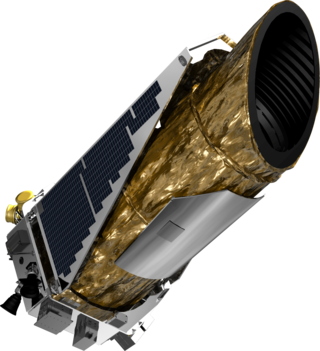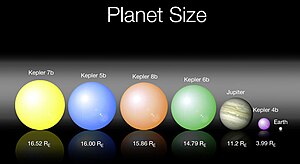
The Kepler space telescope is a disused space telescope launched by NASA in 2009 to discover Earth-sized planets orbiting other stars. Named after astronomer Johannes Kepler, the spacecraft was launched into an Earth-trailing heliocentric orbit. The principal investigator was William J. Borucki. After nine and a half years of operation, the telescope's reaction control system fuel was depleted, and NASA announced its retirement on October 30, 2018.

A super-Earth is an extrasolar planet with a mass higher than Earth's, but substantially below those of the Solar System's ice giants, Uranus and Neptune, which are 14.5 and 17 times Earth's, respectively. The term "super-Earth" refers only to the mass of the planet, and so does not imply anything about the surface conditions or habitability. The alternative term "gas dwarfs" may be more accurate for those at the higher end of the mass scale, although "mini-Neptunes" is a more common term.

HAT-P-7b is an extrasolar planet discovered in 2008. It orbits very close to its host star and is larger and more massive than Jupiter. Due to the extreme heat that it receives from its star, the dayside temperature is predicted to be 2,630–2,880 K K, while nightside temperatures are 2,211–2,238 K. HAT-P-7b is also one of the darkest planets ever observed, with an albedo of less than 0.03—meaning it absorbs more than 97% of the visible light that strikes it.

HAT-P-11b is an extrasolar planet orbiting the star HAT-P-11. It was discovered by the HATNet Project team in 2009 using the transit method, and submitted for publication on 2 January 2009.

Kepler-7b is one of the first five exoplanets to be confirmed by NASA's Kepler spacecraft, and was confirmed in the first 33.5 days of Kepler's science operations. It orbits a star slightly hotter and significantly larger than the Sun that is expected to soon reach the end of the main sequence. Kepler-7b is a hot Jupiter that is about half the mass of Jupiter, but is nearly 1.5 times its size; at the time of its discovery, Kepler-7b was the second most diffuse planet known, surpassed only by WASP-17b. It orbits its host star every five days at a distance of approximately 0,06 AU. Kepler-7b was announced at a meeting of the American Astronomical Society on January 4, 2010. It is the first extrasolar planet to have a crude map of cloud coverage.
Kepler-4 is a sunlike star located about 1610 light-years away in the constellation Draco. It is in the field of view of the Kepler Mission, a NASA operation purposed with finding Earth-like planets. Kepler-4b, a Neptune-sized planet that orbits extremely close to its star, was discovered in its orbit and made public by the Kepler team on January 4, 2010. Kepler-4b was the first discovery by the Kepler satellite, and its confirmation helped to demonstrate the spacecraft's effectiveness.
Kepler-5 is a star located in the constellation Cygnus in the field of view of the Kepler Mission, a NASA project aimed at detecting planets in transit of, or passing in front of, their host stars as seen from Earth. One closely orbiting, Jupiter-like planet, named Kepler-5b, has been detected around Kepler-5. Kepler-5's planet was one of the first five planets to be discovered by the Kepler spacecraft; its discovery was announced on January 4, 2010 at the 215th meeting of the American Astronomical Society after being verified by a variety of observatories. Kepler-5 is larger and more massive than the Sun, but has a similar metallicity, a major factor in planet formation.

Transit-timing variation is a method for detecting exoplanets by observing variations in the timing of a transit. This provides an extremely sensitive method capable of detecting additional planets in the system with masses potentially as small as that of Earth. In tightly packed planetary systems, the gravitational pull of the planets among themselves causes one planet to accelerate and another planet to decelerate along its orbit. The acceleration causes the orbital period of each planet to change. Detecting this effect by measuring the change is known as transit-timing variations. "Timing variation" asks whether the transit occurs with strict periodicity or if there's a variation.
A Kepler object of interest (KOI) is a star observed by the Kepler space telescope that is suspected of hosting one or more transiting planets. KOIs come from a master list of 150,000 stars, which itself is generated from the Kepler Input Catalog (KIC). A KOI shows a periodic dimming, indicative of an unseen planet passing between the star and Earth, eclipsing part of the star. However, such an observed dimming is not a guarantee of a transiting planet, because other astronomical objects—such as an eclipsing binary in the background—can mimic a transit signal. For this reason, the majority of KOIs are as yet not confirmed transiting planet systems.

Kepler-223 is a G5V star with an extrasolar planetary system discovered by the Kepler mission. Studies indicate that the Kepler-223 star system consists of 4 planets orbiting the star.
Kepler-19b is a planet orbiting around the star Kepler-19. The planet has an orbital period of 9.3 days, with an estimated radius of roughly 2.2 times that of the Earth, with a mass around 8.4 times that of the Earth. It is one of three planets orbiting Kepler-19.
Kepler-47 is a binary star system in the constellation Cygnus located about 1055 parsecs away from Earth. The stars have three exoplanets, all of which orbit both stars at the same time, making this a circumbinary system. The first two planets announced are designated Kepler-47b, and Kepler-47c, and the third, later discovery is Kepler-47d. Kepler-47 is the first circumbinary multi-planet system discovered by the Kepler mission. The outermost of the planets is a gas giant orbiting within the habitable zone of the stars. Because most stars are binary, the discovery that multi-planet systems can form in such a system has impacted previous theories of planetary formation.
Kepler-80, also known as KOI-500, is a red dwarf star of the spectral type M0V. This stellar classification places Kepler-80 among the very common, cool, class M stars that are still within their main evolutionary stage, known as the main sequence. Kepler-80, like other red dwarf stars, is smaller than the Sun, and it has both radius, mass, temperatures, and luminosity lower than that of our own star. Kepler-80 is found approximately 1,218 light years from the Solar System, in the stellar constellation Cygnus, also known as the Swan.

Kepler-69 is a G-type main-sequence star similar to the Sun in the constellation Cygnus, located about 2,430 ly (750 pc) from Earth. On April 18, 2013 it was announced that the star has two planets. Although initial estimates indicated that the terrestrial planet Kepler-69c might be within the star's habitable zone, further analysis showed that the planet very likely is interior to the habitable zone and is far more analogous to Venus than to Earth and thus completely inhospitable.
Kepler-61 is a K-type main-sequence star approximately 1,100 light years from Earth in the constellation Cygnus. It is located within the field of vision of the Kepler spacecraft, the satellite that NASA's Kepler Mission used to detect planets that may be transiting their stars. On April 24, 2013 it was announced that the star has an extrasolar planet orbiting in the inner edge of the habitable zone, named Kepler-61b.

Kepler-138, also known as KOI-314, is a red dwarf located in the constellation Lyra, 219 light years from Earth. It is located within the field of vision of the Kepler spacecraft, the satellite that NASA's Kepler Mission used to detect planets transiting their stars.
Kepler-30 is a star in the northern constellation of Lyra. It is located at the celestial coordinates: Right Ascension 19h 01m 08.0747s Declination +38° 56′ 50.219″. With an apparent visual magnitude of 15.5, this star is too faint to be seen with the naked eye. Kepler-30 is exhibiting a strong starspot activity.
Kepler-29 is a Sun-like star in the northern constellation of Cygnus. It is located at the celestial coordinates: Right Ascension 19h 53m 23.6020s, Declination +47° 29′ 28.436″. With an apparent visual magnitude of 15.456, this star is too faint to be seen with the naked eye. It is a solar analog, having a close mass, radius, and temperature as the Sun. Currently the age of the star has not been determined due to its 2780 light-year distance. As of 2016 no Jovian exoplanets of 0.9–1.4 MJ have been found at a distance of 5 AU.

KOI-256 is a double star located in the constellation Cygnus approximately 575 light-years (176 pc) from Earth. While observations by the Kepler spacecraft suggested the system contained a gas giant exoplanet orbiting a red dwarf, later studies determined that KOI-256 was a binary system composed of the red dwarf orbiting a white dwarf.

K2-33 is an extremely young pre-main-sequence star located about 456 light-years (140 pc) away from the Earth in the constellation of Scorpius. It is known to host one planet, a super-Neptune, named K2-33b. It is also notable for its young age.












